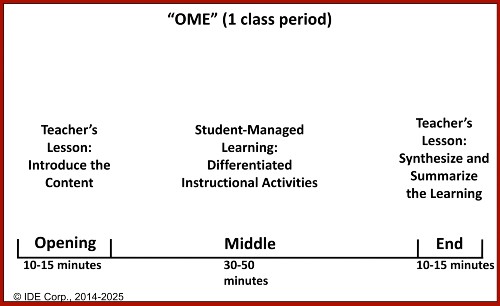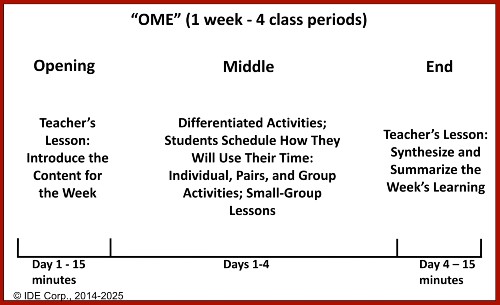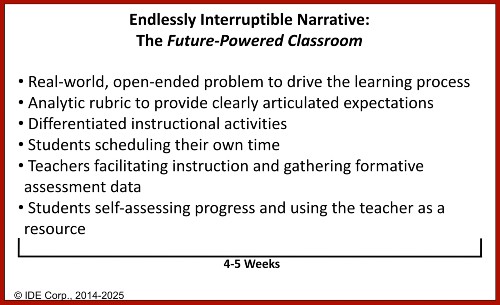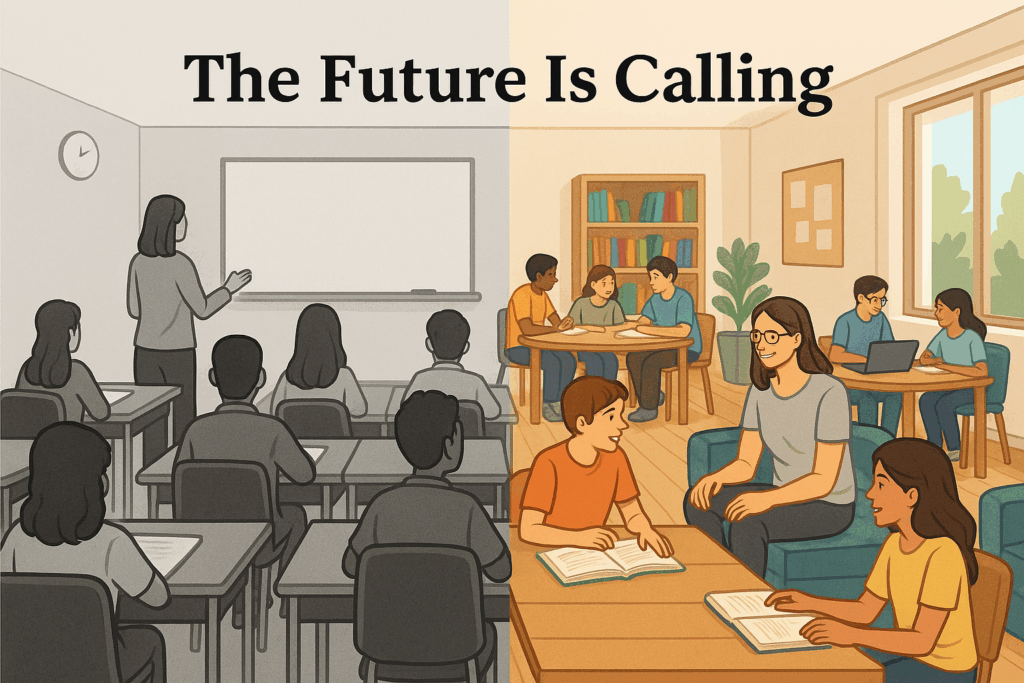If you’re looking to shift your secondary schedule to longer blocks of time and you want to support teachers in thinking differently about time … well, that’s why I’m writing this blog!
What’s Your Why?
I won’t spend too much time on this, but changing a schedule is not a goal, an end, or a why … it’s a structure to address a bigger goal or problem. So be sure you know what that is as you unveil the schedule. All the members of your school community need to buy into your ultimate goal. A block schedule is only a means to a greater end. And these days, that end could be addressing the huge impact AI will have on the job market and the types of mindsets, habits, and skills required from tomorrow’s citizens!
Pioneers and Settlers
Simply put, pioneers run with a vision, dream, and belief that they can bring about a positive change. Settlers sit back with a cup of coffee and wait for the pioneers to report out that it’s okay to follow them. 😉 That pretty much sums up any staff, whether in a company, organization, or school.
Who Are Your Pioneers?
Support your early adopters, or pioneers, in moving innovatively forward and making a difference. Provide them with the professional development and resources they need.
Heck, let them change the room furniture to create functional spaces (I wrote this article in 2018, but it gives you some guidelines for room design.) Let them determine supplies they may need to provide for more student engagement with content.
Let them design their classrooms as “Endlessly Interruptible Narratives!”

Who Are Your Settlers?
For those who may not be ready to dive into full classroom redesign, provide them with a way to rethink instruction in larger blocks of time: a compelling Opening for the class period, a collection of differentiated activities for the Middle, and a synthesis and summary of the content for the Ending. I call this the O-M-E approach, and it’s a powerful start on the road to eventually designing more student-driven classrooms.
Aside: I first developed my two approaches to teaching in the block in brainstorming with a colleague of mine at IDE Corp. back in 1995: Rob Cohen. Unfortunately, the angels came to take Rob way too soon; but a wonderful book about this amazing and unique individual’s life was posthumously published: Krantzman: A Memoir in Stories and Poems. It’s a great read! Rob, I miss our conversations.
So now, to detail these two approaches!
Let’s Start with O-M-E
In this approach, the teacher is still considering a class period as a lesson. If you’re moving to a double period (e.g., from 40 minutes to 80 minutes), then you need to consider two lessons to cover in a class period. The danger is in moving to a slightly longer period, such as 60 minutes, which only adds on 15–20 minutes to the class period and is typically accompanied by dropping one class meeting in a rotation. The danger here is that it’s challenging to consider teaching a topic and then starting on a second with only 15 minutes to spare. The result can be stretching out a lesson and reaching the end of the year 20% short in curriculum coverage. In this case, it might be better to consider all of the topics that would be covered in a week of the traditional period, to now be delivered across one fewer class period. Okay, content in hand . . .
Opening
Why is this content important? What real-world problem could you solve if you were a master of this content? How does this content connect to the future? Now, provide the 10- to 15-minute “keynote” speech! Offer facts, statistics, images, scenarios, metaphors, and anything else to hook students with the “why” of learning the content. (Your AI chatbot can be very helpful here.)
Middle
How can students engage with this content? Through text? Video? Hands-on experiences or experiments? Discussion? Websites? Create a “Differentiated Activity List” with choices for how students will learn, and include options for students who may need to firm up their prerequisite knowledge as well as challenges for those students who may already understand the content. Allow students to map out their plan for the middle of the period and create a schedule. During this time, you might offer a small-group lesson for 10 minutes to support students who may need more direct instruction from you, or you might offer the same for those who have mastered this content and need to be challenged at a higher level. You do need to facilitate those working independently, however, so after such a lesson, be sure to leave time to move around the room and engage with students who are working before conducting another. Unless you’re teaching in an 80-minute block, you may only be able to offer one. (I say this so you won’t fall into the trap of teaching from the side of the room and ignoring the rest of the class while they are engaged in meaningful learning and probably could use your facilitation.)
End
With 10–15 minutes to spare, engage the class in a discussion of takeaways, application ideas, and questions to solidify the learning you want them to have. Typically, when students sit-and-get new content, some are hesitant to raise a hand to answer or ask a question, as they have not yet processed the information. By switching to an O-M-E approach, students grapple with the content before the whole-group lesson (which is now at the end of the period). This will increase the number of students who have the confidence to participate.


Endlessly Interruptible Narrative
Think of how you read a newspaper (physical or online), watch a television show, or navigate the web. You begin taking in content and then it’s interrupted with an advertisement or a related link that you wish to follow before continuing or announcements of other articles you might like. You follow the new content and then, at some point, return to the original content you were consuming. Funny thing is, your brain picks right back up. Our brains don’t work in 42-minute periods or 80-minute periods or any-minute periods! We do not live segmented lives; we live in an endlessly interruptible narrative. So why not have the classroom experience mirror that?
I designed the Learner-Active, Technology-Infused Classroom (LATIC) in the 1980s and detailed it in my Students Taking Charge books (K–5, 6–12, leadership guide). Very recently, I redesigned the approach to address the advent of AI and the need to prepare students to live and work alongside powerful non-human coworkers, thought partners, and detail doers. My Future-Powered Classroom (book not yet out, sorry!), like LATIC, focuses on putting students in charge of their own learning. And it does share components of the O-M-E approach; however, the content is not constrained in short periods of time. Instead, students are challenged to address a project- or problem-based task (see the 6 Ps of PBL video) over a period of 4 to 5 weeks. Guided by an Analytic Rubric and Differentiated Activity Lists, students manage their own time and work toward their goals.

The teacher becomes a curator of a rich, differentiated, immersive environment and the facilitator of learning. Using a Content Facilitation Grid, the teacher tracks student progress; armed with Five Levels of Facilitation Questions, the teacher assesses and pushes student thinking; and guided by a Facilitation Roadmap, the teacher assesses a student’s mindset and provides appropriate support and direction.
Teachers report increased student engagement, greater and deeper coverage of content, and higher test scores.
If your teachers are ready to move in this direction, I’d recommend the book Students Taking Charge, as previously mentioned.
The Future Is Calling
As AI transforms the job market, our classrooms must evolve, too. Block scheduling isn’t just a structural change: it’s an opportunity to rethink teaching and learning. Whether you choose O-M-E (Open–Middle–End) or the Endlessly Interruptible Narrative, the important thing is that you embark on innovation to prepare students for a very different future. Pioneers and settlers are all welcome, as long as no one stays behind. The future is calling … let’s answer it boldly. (Image compliments of ChatGPT based on its interpretation of this blog post.)

While IDE Corp. provides keynotes and consulting services in these areas, our most popular approach with today’s digitally connected teachers is our online, on-demand Professional Learning Experiences, which serve as resources for a school looking to innovate teaching in the block. Of the titles offered, I recommend “Fostering Student Agency Through Differentiated Activity Lists.” This would support teachers in developing the middle of O-M-E and the general approach to teaching in the Endlessly Interruptible Narrative. Additionally, the PLE “Teaching Through the 6 Ps of PBL” (release date: July 30, 2025) would be useful for the latter approach to build PBL units. PLEs are sold as full-school enrollment for 2 years, to be used in faculty meetings, PD days, PLC meetings, planning meetings, and individually to innovate instruction. For more information, visit learn.edquiddity.com or contact Nicole (Nik) Koch at solutions@idecorp.com
